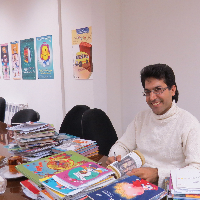Stylistics of "Physical Metamorphosis" in Child Stories, based on The Tensive Regime of Discourse
"Physical Metamorphosis" is the change in the identity of the acting element or the actress of the story, from a physical representation to another physical expression. In the present study, the word "physical" in addition to the metamorphosis of the body, as a body, also refers to the metamorphosis of the body as an object. "Physical Metamorphosis" either as a knot method, is the creator of a tensive space, or like a resolver method, derived from a tensive space. To examine the aforementioned method, however the choice of the "tensive regime of discourse, is a proportional choice.
The purpose of this study is to classify the stories in the range of children that have been developed around the "Physical Metamorphosis". Questions: In this regard, the present study seeks to answer three questions: 1. how the style of the elements involved in metamorphosis take the advantage of tensive regime of discourse to produce meaning in the child story? 2. What is the relationship between the level of consciousness of its transformation element and the amount of its transformation process? 3. Based on the model proposed by Zilberberg, how is it possible to define and illustrate these styles?
The two-component stylistics of this study uses two coordinates systems perpendicular to each other: one in terms of time-metamorphosis, which shows the qualitative changes of metamorphic action, in a quantitative period of time, and the other in terms of time-consciousness, which represents the qualitative changes in the consciousness of the actor submissive subject towards his metamorphosis. In this study, "metamorphosis", as well as "the subjectchr('39')s mental awareness of its own metamorphosis", are both considered a qualitative component, alongside linguistic content, and "time" as a quantitative and extrinsic component. The present study uses a descriptive analysis approach.
1) Zilberberg believes in five styles or modes of presence: style of modality, style of efficiency, style of existence, inclusive and exclusive style. According to the present study, this stylistics can be divided into two groups. The first group includes style of modality, style of efficiency, and style of existence. These three styles are relative to each other being in complementary distribution; that is, although all three are stressful, and have relatively similar functions; but none of both items come together. The second group includes, inclusive and exclusive style. Both components are in complementary distribution relative to each other; but none of the three styles of the first group, with any of the two styles of the second group, are in complementary distribution; For example, the stress space can be both style of modality (from the first group) and inclusive style (from the second group). 2) The first group, which includes three styles of modality, efficiency and existence, divides both the metamorphic process and the pattern of awareness of the metamorphic element towards its own metamorphosis. Based on these two components, we can identify the cognitive style pattern of physical metamorphosis in childrenchr('39')s stories based on two components: The first is metamorphosis at the biological level, and the other is metamorphosis at the phenomenological level. 3) Childrenchr('39')s stories, which are based on bodily metamorphosis, follow six two-component models: I) The efficiency, with the phenomenon of modality, II)The double efficiency, III)The double modality, IV)The modality with the phenomenon of efficiency, V)The existence, VI) Without the phenomenon. This study, for the first time, generalizes Zilberbergchr('39')s one-component stylistic model to two-component stylistic paradigm. In two-component stylistics, the first component represents the objective process of the biological changes of the transformed personality, and the second component represents the phenomenological changes that occur in mind of the transformed personality. That is, the coordinate system based on "time-metamorphosis" corresponds to the first component, and shows how the objective the process of metamorphosis is. The coordinate system based on "time-awareness" corresponds to the second component, and shows how the personality is aware and mentally informed of its metamorphosis. In this article, the representation of stress axes (extent and intensity axes) are completely consistent with mathematical paradigms.
Significance of the study: Regarding the frequency of the application of the "Physical Metamorphosis" in children story, and the lack of theoretical research on this field, the necessity of conducting a research in this field sounds beneficial.
- حق عضویت دریافتی صرف حمایت از نشریات عضو و نگهداری، تکمیل و توسعه مگیران میشود.
- پرداخت حق اشتراک و دانلود مقالات اجازه بازنشر آن در سایر رسانههای چاپی و دیجیتال را به کاربر نمیدهد.



